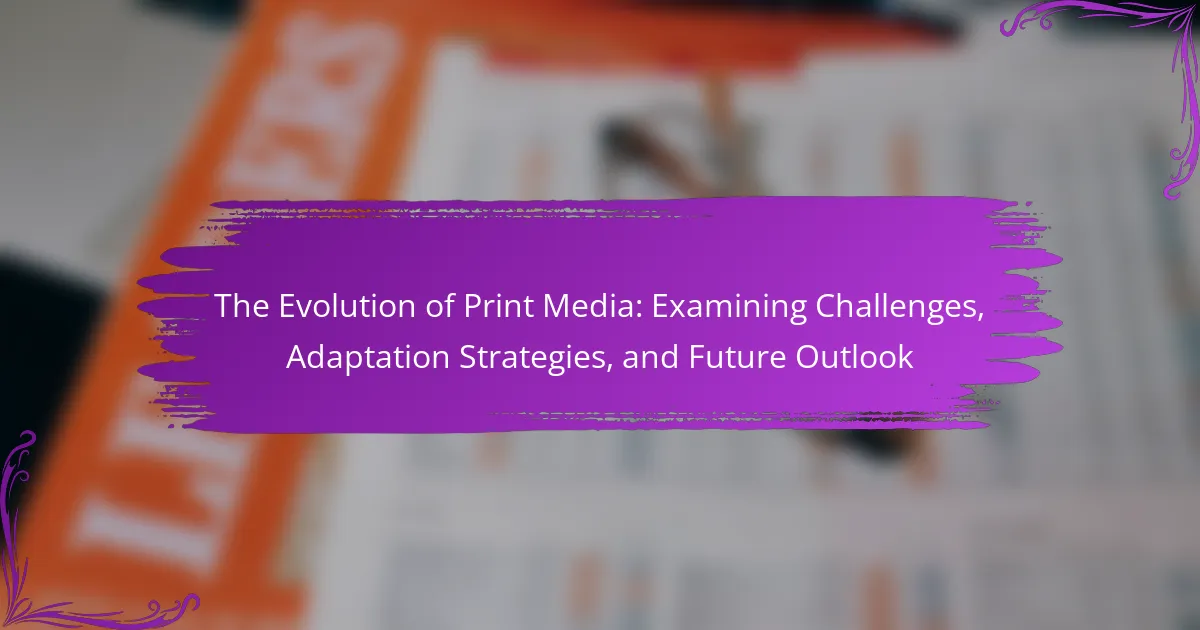
What is the Evolution of Print Media?
The evolution of print media began with the invention of the printing press in the 15th century. Johannes Gutenberg’s press revolutionized the production of books, making them more accessible. This innovation led to the spread of literacy and ideas during the Renaissance. In the 19th century, advancements in technology introduced lithography and offset printing. These methods improved print quality and reduced costs. The 20th century saw the rise of newspapers and magazines as primary information sources. However, the digital age in the late 20th century began to challenge print media’s dominance. Online platforms offered instant access to information, affecting print circulation. Today, print media adapts by integrating digital strategies while maintaining its unique value.
How has print media changed over the decades?
Print media has evolved significantly over the decades. Initially, print media was dominated by newspapers and magazines, which were the primary sources of information. In the 1960s and 1970s, print media experienced a golden age, with high circulation rates and advertising revenues. However, the rise of digital technology in the 1990s began to shift consumer preferences toward online content. By the 2000s, many print publications faced declining readership and financial challenges. In response, print media adapted by developing digital versions and integrating multimedia content. Today, print media continues to coexist with digital platforms, focusing on niche markets and high-quality journalism. The transition reflects broader changes in technology and consumer behavior.
What major technological advancements have influenced print media?
Digital printing technology has significantly influenced print media. This advancement allows for quicker production times and lower costs. It enables on-demand printing, reducing waste and inventory needs. The introduction of desktop publishing revolutionized layout and design. Software like Adobe InDesign and QuarkXPress empowered individuals and small businesses to create professional-quality materials. Online platforms have shifted advertising and distribution methods for print media. Social media and digital marketing have changed how print media reaches audiences. These technological advancements have transformed the industry landscape, driving innovation and adaptation.
How have consumer preferences shaped the evolution of print media?
Consumer preferences have significantly influenced the evolution of print media. As audiences increasingly demand personalized and relevant content, print media has adapted by focusing on niche markets. The rise of digital media has shifted consumer expectations towards immediacy and interactivity. Consequently, print publications have integrated multimedia elements and enhanced visual designs to engage readers effectively. Additionally, the preference for sustainability has prompted print media to adopt eco-friendly practices. Research indicates that 70% of consumers prefer brands that demonstrate environmental responsibility. This shift has led to the use of recycled materials and sustainable printing processes in the industry. Overall, print media continues to evolve in response to changing consumer preferences, ensuring its relevance in a digital age.
What are the key challenges faced by print media today?
The key challenges faced by print media today include declining readership, revenue loss, and competition from digital platforms. Print media has seen a significant drop in circulation numbers. According to the Pew Research Center, daily newspaper circulation in the U.S. fell by 50% from 2004 to 2019. This decline in readership translates to reduced advertising revenue. Many advertisers now prefer digital platforms that offer targeted advertising options. Additionally, the rise of social media has shifted audience attention away from traditional print sources. Print media also faces challenges in adapting to new technologies and consumer preferences. These factors collectively threaten the sustainability of print media in the current landscape.
How has digital media impacted the print industry?
Digital media has significantly impacted the print industry by reducing print circulation and revenue. Many consumers now prefer online content due to its accessibility and convenience. According to the Pew Research Center, print newspaper circulation has declined by over 50% since 2004. Advertising revenue for print media has also dropped, as advertisers shift budgets to digital platforms. This shift forces print companies to adapt by diversifying their offerings, including digital products. Some print publishers have adopted hybrid models, combining print and digital formats to reach broader audiences. The impact of digital media has led to a reevaluation of business strategies within the print industry.
What financial challenges are currently affecting print media companies?
Print media companies face significant financial challenges today. Declining advertising revenue is a primary issue, with many advertisers shifting to digital platforms. According to the Pew Research Center, print advertising revenue dropped by 62% from 2006 to 2020. Additionally, circulation numbers have decreased as consumer preferences shift towards online content. The same Pew Research Center report highlights that daily newspaper circulation fell by 50% during the same period. Rising production costs further strain budgets, impacting profitability. Many print companies also struggle with outdated business models that fail to adapt to current market demands. These financial challenges threaten the sustainability of print media in an increasingly digital landscape.

What adaptation strategies are being employed in print media?
Print media is employing several adaptation strategies to remain relevant in a digital age. These strategies include diversification of content formats, such as integrating digital platforms with traditional print. Many print media outlets are enhancing their online presence through websites and social media. This shift allows them to reach wider audiences and engage readers interactively.
Additionally, print media is focusing on niche markets to cater to specific demographics. By producing specialized content, they can attract dedicated readerships. Subscription models are also being adopted, offering readers exclusive content for a fee. This approach helps to generate revenue in an era of declining advertising income.
Furthermore, print media is investing in high-quality journalism and investigative reporting. This commitment to quality sets them apart from the vast amount of unverified information online. Collaborations with technology companies are also being explored to innovate distribution methods and improve user experience.
Finally, sustainability practices are being integrated into production processes. Many print media companies are using eco-friendly materials and practices to appeal to environmentally conscious consumers. These adaptation strategies collectively aim to ensure the continued viability of print media in a rapidly changing landscape.
How are print media companies innovating to stay relevant?
Print media companies are innovating by integrating digital technologies and diversifying content formats. They are adopting online platforms to reach wider audiences. Many companies are creating multimedia content, combining text, audio, and video. Subscription models are being implemented to generate stable revenue streams. Data analytics is utilized to understand reader preferences and tailor content accordingly. Collaborations with tech firms enhance distribution and engagement strategies. Some companies are focusing on niche markets to build loyal readerships. Innovations in sustainable printing practices are also being explored to appeal to environmentally conscious consumers. These strategies help print media companies remain competitive in a rapidly evolving landscape.
What role does diversification play in the adaptation of print media?
Diversification plays a crucial role in the adaptation of print media. It allows print media to explore various content formats and distribution channels. By expanding into digital platforms, print media can reach broader audiences. This strategy mitigates the decline in traditional print circulation. For instance, many newspapers have developed mobile apps and websites. These adaptations help maintain relevance in a digital-first world. Additionally, diversification includes offering multimedia content, such as videos and podcasts. This approach enhances engagement and attracts younger demographics. Overall, diversification is essential for the survival and evolution of print media.
How are print media companies leveraging digital platforms?
Print media companies are leveraging digital platforms to reach wider audiences and enhance engagement. They create online versions of their publications, allowing for instant access. Many companies utilize social media to share content and interact with readers. This strategy increases visibility and drives traffic to their websites. Print media also employs digital advertising to generate revenue. Interactive content, such as videos and polls, is integrated to enhance reader experience. Analytics tools are used to track reader behavior and preferences. This data informs content strategy and advertising effectiveness. Overall, digital platforms provide print media companies with innovative ways to adapt and thrive in a changing landscape.
What are some successful case studies of adaptation in print media?
Successful case studies of adaptation in print media include The New York Times and National Geographic. The New York Times implemented a digital subscription model in 2011. This strategy led to over 10 million digital subscribers by 2022. National Geographic adapted by enhancing its visual storytelling and embracing digital platforms. Their magazine now features augmented reality content, engaging younger audiences. Both entities showcase effective adaptation to changing consumer preferences and technological advancements. Their success illustrates the importance of innovation in print media.
Which print publications have successfully transitioned to digital formats?
The New York Times has successfully transitioned to digital formats. It offers a robust online subscription model. As of 2023, it has over 10 million digital subscribers. National Geographic has also made a successful shift. Its digital platforms feature interactive content and documentaries. The Wall Street Journal has a strong digital presence as well. It provides news through various online channels. Time magazine has adapted by offering digital editions and apps. These publications demonstrate effective strategies in the digital landscape.
What lessons can be learned from these successful adaptations?
Successful adaptations in print media highlight the importance of innovation and flexibility. Entities that embraced digital transformation have thrived. For instance, newspapers that developed online platforms saw increased readership. They leveraged multimedia content to engage audiences effectively. Moreover, successful adaptations emphasized the need for audience understanding. Tailoring content to meet the preferences of diverse demographics proved beneficial. Furthermore, collaboration with technology partners enhanced distribution and accessibility. These strategies illustrate that adaptability and audience focus are critical for survival in a changing landscape.

What is the future outlook for print media?
The future outlook for print media is increasingly challenging yet adaptable. Print media faces declining circulation and advertising revenue due to digital alternatives. However, niche markets and high-quality publications still thrive. According to the Pew Research Center, print newspaper circulation fell by 7% from 2019 to 2020. Despite this, specialized magazines and local newspapers have found ways to engage their audiences. Many print media outlets are incorporating digital strategies to enhance their reach. The integration of print and digital platforms may offer new opportunities for growth. Overall, while print media is evolving, it continues to hold relevance in specific contexts.
How is the role of print media expected to evolve in the coming years?
The role of print media is expected to shift towards a more niche and specialized function. As digital media continues to dominate, print media will likely focus on quality over quantity. This includes producing high-quality publications that cater to specific audiences. Print media may also enhance its integration with digital platforms. For example, many print publications now include QR codes linking to online content. Furthermore, sustainability will become a key focus, with more eco-friendly practices being adopted. The decline in general readership will push print media to innovate in content delivery and design. Overall, print media will adapt by emphasizing unique content and creating a more engaged reader experience.
What trends are emerging that could shape the future of print media?
Digital integration is a key trend shaping the future of print media. Publishers are increasingly blending print with digital formats. This includes QR codes linking to online content. Additionally, augmented reality is being utilized to enhance print experiences. Sustainability is another significant trend. Eco-friendly materials and practices are becoming a priority for many publishers. Subscription models are evolving as well, with more readers opting for digital subscriptions. Data-driven strategies are also emerging, allowing for targeted advertising and personalized content. These trends indicate a shift towards a more interactive and sustainable print media landscape.
How might consumer behavior influence the future of print media?
Consumer behavior significantly influences the future of print media by determining its demand and relevance. As digital platforms continue to dominate, consumer preferences shift towards online content. This trend leads to declining print circulation and advertising revenues. According to a 2022 Pew Research study, 30% of adults in the U.S. prefer digital news over print. Additionally, younger generations prioritize instant access to information, further diminishing print media’s appeal. Print media must adapt by integrating digital strategies to engage consumers effectively. This adaptation may include offering hybrid subscriptions or enhancing interactive features in print publications. The evolution of consumer behavior will ultimately dictate print media’s viability in a digital-centric world.
What practical strategies can print media companies implement for future success?
Print media companies can implement digital integration as a practical strategy for future success. This involves developing online platforms to complement print offerings. Engaging with audiences via social media enhances visibility and interaction. Diversifying revenue streams through subscriptions, events, and merchandise can increase profitability. Investing in data analytics helps understand audience preferences and tailor content effectively. Collaborating with advertisers for targeted campaigns can maximize ad revenue. Focusing on sustainability in production can appeal to environmentally conscious consumers. Adapting to new technologies, such as augmented reality, can enhance reader experience and engagement.
How can print media companies enhance reader engagement?
Print media companies can enhance reader engagement by incorporating interactive elements in their publications. This includes using QR codes that link to digital content. Engaging visuals and infographics can also capture attention effectively. Personalized content tailored to reader preferences increases relevance and interest. Hosting events or discussions related to featured articles fosters community involvement. Implementing feedback mechanisms allows readers to express their opinions. Offering exclusive content for subscribers can incentivize loyalty. Collaborations with local businesses can create unique promotional opportunities. These strategies have been shown to improve reader retention and satisfaction.
What best practices should print media companies adopt to thrive in a digital age?
Print media companies should adopt a multi-platform strategy to thrive in a digital age. This approach includes developing a strong online presence through websites and social media. Engaging with audiences via digital channels enhances reach and visibility. Additionally, offering multimedia content can attract diverse demographics. Print media should also focus on data analytics to understand reader preferences. This information can guide content creation and distribution strategies. Collaborating with tech companies can improve digital capabilities. Finally, diversifying revenue streams through subscriptions and advertising is essential for sustainability. These practices are supported by trends indicating increased digital consumption among audiences.
The main entity of the article is print media, which has undergone significant evolution since the invention of the printing press in the 15th century. The article examines the historical changes in print media, highlighting technological advancements, shifting consumer preferences, and the impact of digital media on print circulation and revenue. Key challenges faced by print media today include declining readership and competition from digital platforms, prompting adaptation strategies such as diversification, digital integration, and a focus on niche markets. The article also explores successful case studies of print media adaptation and outlines practical strategies for future success, emphasizing the importance of innovation and sustainability in maintaining relevance in a digital age.



